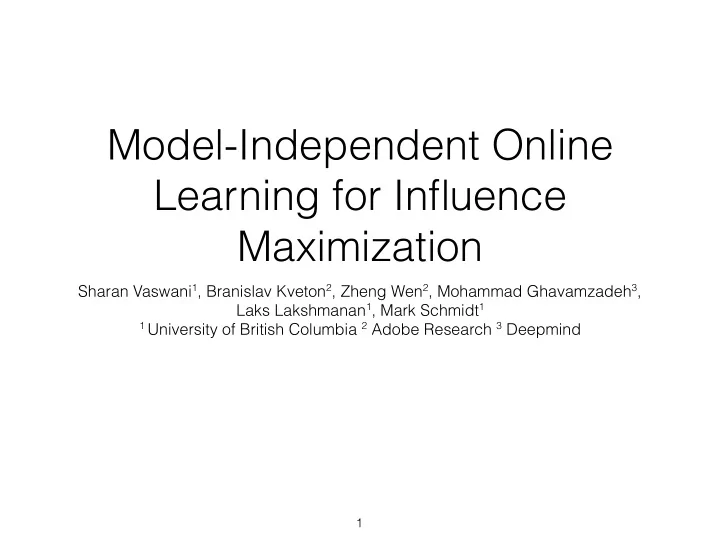

Model-Independent Online Learning for Influence Maximization Sharan Vaswani 1 , Branislav Kveton 2 , Zheng Wen 2 , Mohammad Ghavamzadeh 3 , Laks Lakshmanan 1 , Mark Schmidt 1 1 University of British Columbia 2 Adobe Research 3 Deepmind 1
Influence Maximization Underlying principle: Influence propagates through ‘word of mouth’ in a social network Idea: Give discounts to ‘influential’ users who will trigger off word-of-mouth epidemics Aim: Find a subset of users (‘seed set’) who will influence maximum people to become aware of a product 2
Influence Maximization Input : Stochastic diffusion Model Set of feasible seed sets Weighted Graph E.g: Objective: Find Pr (S influences target node v) Expected number of nodes influenced by S Key Property: For common diffusion models, is submodular in S 3
Influence Maximization Challenges to using IM in practice: • Challenge 1: IM is not robust to the choice of the diffusion model [1] nor its model parameters [2]. • Challenge 2: Learning model parameters requires considerable data, often unavailable to a new marketer. [1] Du, Nan, et al. "Influence function learning in information diffusion networks." ICML, 2014 [2] Goyal, Amit, et al. "Learning influence probabilities in social networks." WSDM, 2010 4
Model Independent Formulation Assumption 1: F(S) is monotonic in S. Key Idea: Parametrize the problem in terms of pairwise reachability probabilities Pr(u influences v under a diffusion model) Surrogate Objective: Find v u1 u2 Advantages: • Common parametrization for all progressive models. • Guaranteed approximation. • Surrogate objective is submodular irrespective of the diffusion model. 5
Influence Maximization Challenges to using IM in practice: • Challenge 1: IM is not robust to the choice of the diffusion model [1] nor to the model parameters [2]. • Challenge 2: Learning model parameters requires considerable data, often unavailable to a new marketer. 6
Online Influence Maximization Setting: New marketer who has no past data to learn the reachability probabilities Idea: Perform IM while simultaneously learning through trial and error across multiple rounds. Basic Protocol: submodular optimization subroutine probability estimates • • Di ff usion occurs according to an underlying di ff usion model. • Observe semi-bandit feedback. size n binary vector. each entry = 1 iff that node is influenced by the seed u • Update parameter estimates 7
Online Influence Maximization 2 reachability probabilities Challenge 1: Learn n Vector to be learnt for every source node. d dimensional feature describing a target node (Eigenbasis features, node2vec [3]) Advantages: • Reduces the number of parameters from O(n 2 ) to O(dn). • In each round, mean estimates of can be updated by solving K regression problems. [3] Grover, Aditya, et al. "node2vec: Scalable feature learning for networks." KDD, 2016. 8
Online Influence Maximization Challenge 2: Trade off exploration and exploitation Basic Idea: Use the Upper Confidence Bound algorithm i.e. use overestimate (mean + variance) of reachability probabilities as input to the oracle. Computational Complexity: oracle computation UCB computation + Per-round time: 9
Online Influence Maximization Performance metric: Optimal seed set in hindsight Selected seed set Regret after T rounds To account for the approximation in ORACLE Regret Bound: standard combinatorial near optimal dependence bandit dependence Surrogate approximation factor ORACLE approximation factor best dependence on network size standard linear bandit dependence 10
Experiments on Facebook dataset 5 5 14 x 10 18 x 10 16 CUCB(10) CUCB(10) 12 TAB(10) TAB(10) I(10,50) I(10,50) 14 L(10,50) L(10,50) 10 Cumulative Regret 12 Cumulative Regret 8 10 8 6 6 4 4 2 2 0 0 0 1000 2000 3000 4000 5000 0 1000 2000 3000 4000 5000 Number of rounds Number of rounds IC model LT model 11
Conclusion Contributions: • Developed a model-independent parametrization for IM and proposed a surrogate objective function. • Proposed and analyzed a UCB based algorithm for model-independent online IM. Future Work: • Extend the framework to different feedback models and bandit algorithms. • Generalization across source nodes for better statistical efficiency. 12
Recommend
More recommend